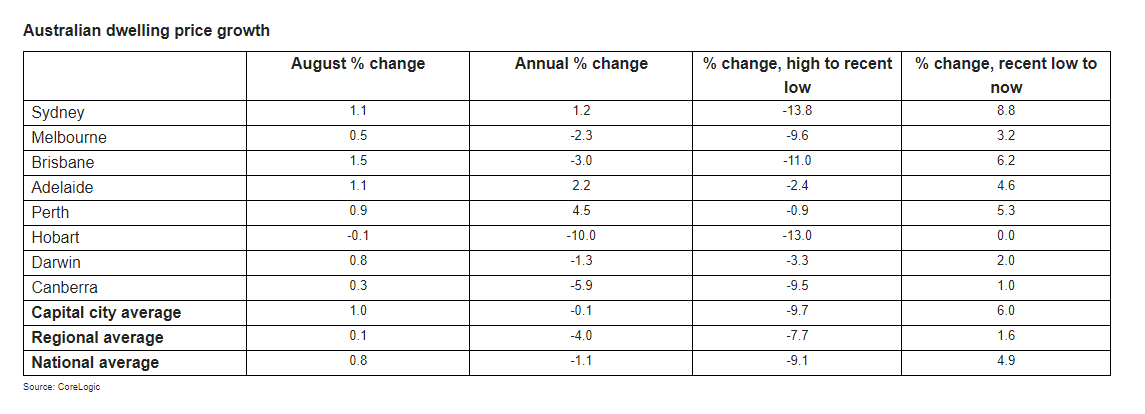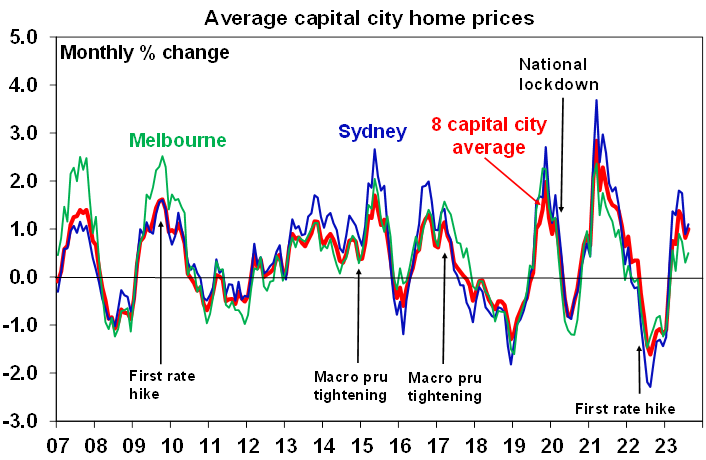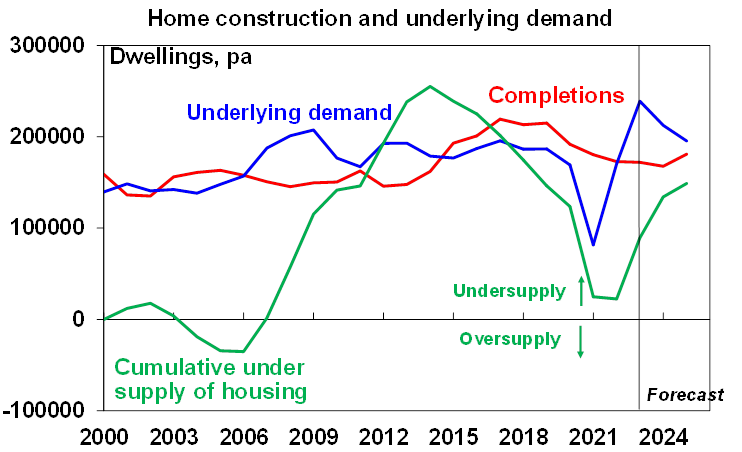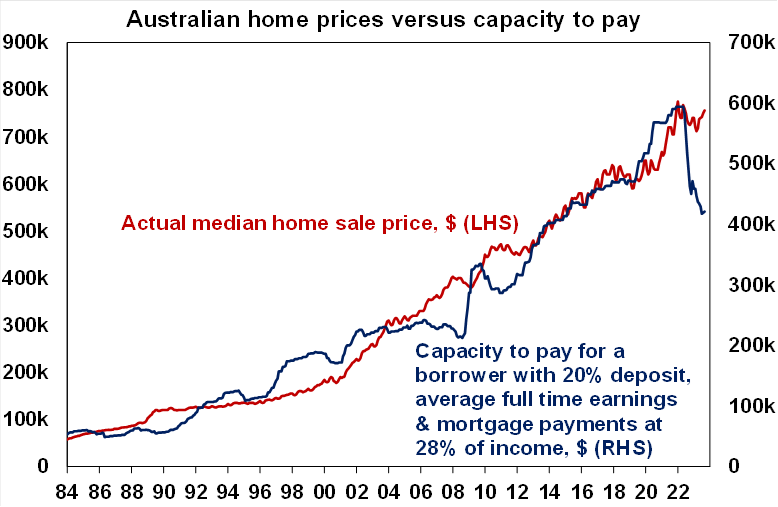Dr Shane Oliver, Head of Investment Strategy & Chief Economist at AMP, discusses home price growth.Key points:- CoreLogic data showed national average home prices rose 0.8% in August, up slightly from 0.7% in July, their sixth monthly rise in a row. They are now up 4.9% from their February low.
- Monthly gains are down from 1.2% in May, but remain strong.
- Monthly gains were strong in Sydney, Brisbane, Adelaide and Perth but prices fell in Hobart and gains were weak in Canberra and Melbourne. Such dispersion is not unusual. Sydney property prices led on the way down early last year and they led on the way up early this year.
- The rebound in prices since February reflects a surge in underlying demand on the back of high immigration and constrained supply dominating the negative impact of higher interest rates.
- Our base case is that property prices have seen the low for this cycle and will rise around 5% next year as interest rates start to fall.
- However, our confidence in this forecast remains low as the risk of another leg down in prices is high as interest rate hikes continue to impact and the economy slows pushing up unemployment. So far though the property market has proven pretty resilient.
 Home price gains down from their recent high but still strong
Home price gains down from their recent high but still strongCoreLogic national average home price data shows a 4.9% rise from their February low, with the rate of increase down from their May high but still strong at 0.8%mom nationally and 1%mom on average in capital cities.

Source: CoreLogic, AMP
The fundamental supply shortfall continues to dominateThe rebound in prices since February this year continues to reflect a worsening shortfall of supply relative to underlying demand for homes as a result of the rebound in immigration driving the fastest population growth in 15 years at the same time that the supply of new dwellings is slowing. As a result, the property market is moving back into a significant undersupply. See the next chart. This in turn accentuated already very tight rental markets, forcing rents up and driving renters to consider buying earlier than they otherwise would have. At the same time foreign demand is returning. So, buyer demand has been strong but supply remains weak with total listings up from their lows but still below normal. Talk of rising prices and shortages has in turn further boosted demand with an element of FOMO attracting less interest rate sensitive buyers into the market. Expectations that interest rates are at or close to the top has likely also helped.

Source: ABS, AMP
Our base case is that property prices have seen the low for this cycle and will rise around 5% next year as interest rates start to fall.
However, the uncertainty around the property outlook is very highOn the one hand the chronic housing undersupply is a strong force pushing home prices higher. Against this, the impact of the rise in mortgage rates since May last year is still feeding through and unemployment is likely to rise significantly over the next year.
- Even though rates may have peaked, there has been a big hit to home buyer “capacity to pay” which remains in place – we estimate that the capacity to pay for a home for a borrower with a 20% deposit on full time average earnings is around 29% lower than it was in April last year. The rapid reversal in the capacity to pay since May last year due to the surge in mortgage rates threatens a downwards adjustment in home prices at some point unless incomes rise dramatically or mortgage rates fall dramatically. This adjustment in prices could come once (or if) housing demand from less interest sensitive buyers is exhausted.
- There is a high risk of increased listings by distressed sellers – this may come from variable rate borrowers and the rollover of fixed rate mortgages which is now underway. On the RBA’s estimates more than 15% of variable rate borrowers (which covers about 1 million people) will have negative cash flow by year end. All of which when combined with higher unemployment as the economy slows could lead to an increase in listings by distressed sellers. In fact, we have seen an unseasonal rise in new listings through July which may reflect some combination of homeowners just concluding that now is a good time to sell and/or a pick-up in distressed selling. So far though the rollover of fixed rate borrowers to much higher rates appears to be occurring without major problems, but there is still a way to go yet.
- At the same time, rising rents are likely to reduce some of the tightness in the rental market by encouraging more young people to move into share accommodation or to stay at home longer with their parents thereby pushing household size back up to pre-pandemic levels, which will ease some of the pressure in rental markets.
- Similarly, were the economy to slide into recession it’s likely that the Government would cut the immigration intake, further reducing the underlying demand/supply imbalance.
- In the last three major cyclical upswings in home prices lower interest rates have been required to drive a sustained rise in home prices and this is unlikely until next year. So, the rebound in home prices so far this year looks premature relative to the normal cyclical relationship with interest rates.

Source: RBA, CoreLogic, AMP
So, while our base case is that home prices have bottomed, there remains considerable uncertainty around this, or even if they have the higher level of interest rates will likely act as a constraint on how far home prices can rise even in the face of the shortfall of supply relative to underlying demand.
EndsImportant note: While every care has been taken in the preparation of this document, neither National Mutual Funds Management Ltd (ABN 32 006 787 720, AFSL 234652) (NMFM), AMP Limited ABN 49 079 354 519 nor any other member of the AMP Group (AMP) makes any representations or warranties as to the accuracy or completeness of any statement in it including, without limitation, any forecasts. Past performance is not a reliable indicator of future performance. This document has been prepared for the purpose of providing general information, without taking account of any particular investor’s objectives, financial situation or needs. An investor should, before making any investment decisions, consider the appropriateness of the information in this document, and seek professional advice, having regard to the investor’s objectives, financial situation and needs. This document is solely for the use of the party to whom it is provided. This document is not intended for distribution or use in any jurisdiction where it would be contrary to applicable laws, regulations or directives and does not constitute a recommendation, offer, solicitation or invitation to invest.